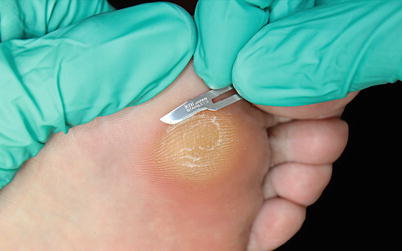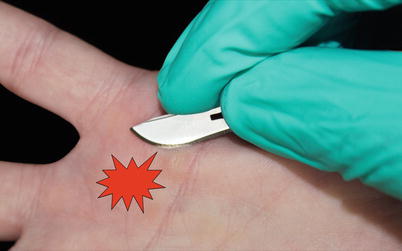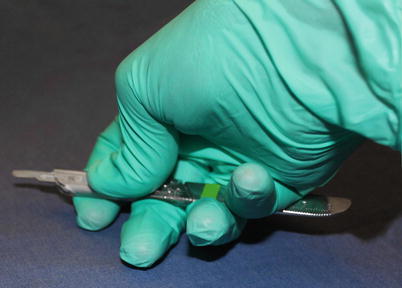Fig. 14.1
Improperly using a #11 blade (which is straight) for paring. Unintended contact of proximal and distal ends of the blade to normal skin occurs
Solution
Use a #15 blade (Fig. 14.2). #15 blades are convex and small enough to control comfortably. Note traction of the thumb behind the blade and opposite to blade motion.

Fig. 14.2
Convex edge of the #15 blade contacts target without injuring surrounding normal skin
Accidents Happen When
A large blade is used to pare a small lesion (Fig. 14.3). Larger convex blades can cause unintended injury to lesion margins.

Fig. 14.3
#10 blades and #22 blades are often too broad to pare smaller lesions
Solution
Use a #15 blade.
Accidents Happen When
Paring is performed without traction. Bunching of tissue, slippage, and uncontrolled blade movement can result in a laceration to physician or patient (Fig. 14.4).

Fig. 14.4
No traction can result in laceration from blade slippage
Accidents Happen When
Paring is attempted without a blade handle (Fig. 14.5). Nerve injury to the finger pad can result when paring densely hyperkeratotic lesions with high resistance.

Fig. 14.5
Finger pad injury with prolonged, repeated, high pressure from the blade when not using a blade handle. (a) High pressure. (b) Resultant indentation associated with dysesthesia
Solution 1
The blade can safely be used off the handle for smaller, softer lesions.

Fig. 14.6
Holding the scalpel like a pencil yields fine control but may strain the index finger and thumb, which bear the brunt of skin resistance
Solution 3
Use a blade handle wedged against the index finger and fourth web space. Fingers are fixed during paring, which occurs with wrist flexion (Fig. 14.7).










